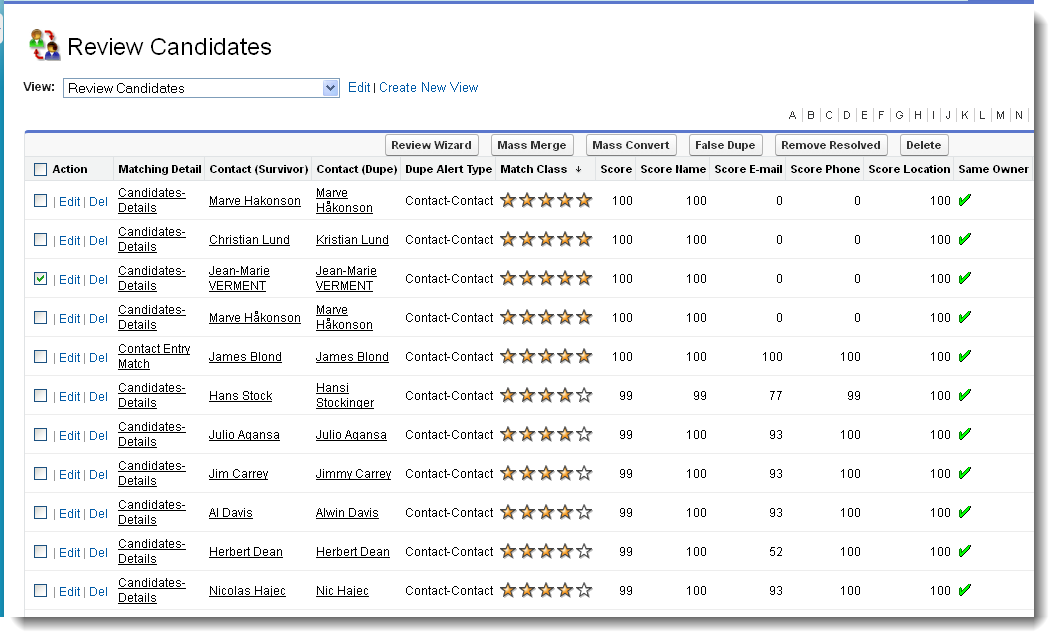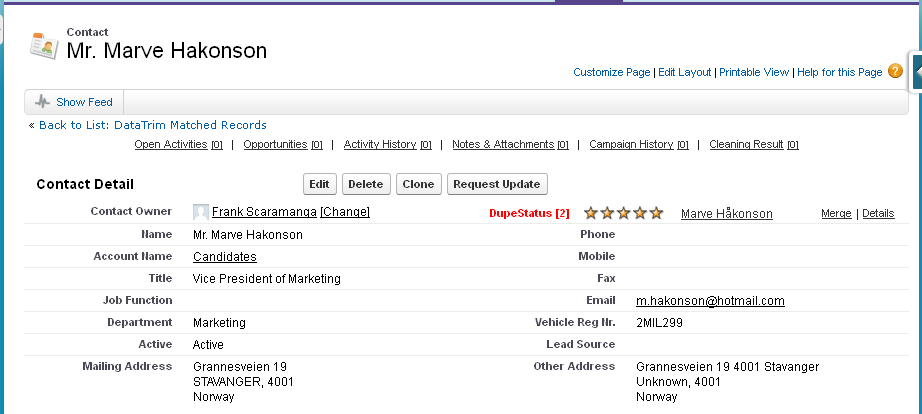When consolidating candidates in world class recruitment solutions and getting the possibility to more effectively manage and automate your recruitment efforts, the challenge of dealing with duplicate data is more important than ever.
Deduping candidates and deduping business contacts are not the same thing, prepare yourself for the pitfalls
Top 5 things to consider when deduping candidates in a recruitment solution:
- 1. Help users search properly before they create a new candidate. Don’t use the “I’ll-slap-you-over-the-fingers-if-you-do-this-again” approach, help them, guide them to avoid that they create a duplicate
- 2. Job applications from a web-site should be scanned before they are being processed. Only this way can it be updated with historic information from existing candidate records if it exists.
- 3. Processing deduplications on data already existing in your database is required to clean up existing data. Scheduled or ad hoc deduplications are also a necessity to provide an underlying safety net for duplicates which may pass the 2 steps above.
- 4. Engage your recruiters in the clean-up process. Let them review and merge records on the fly when they come across duplicates in your database; this creates ownership of data and helps you share the workload.
- 5. Consider also that a candidate may be one of your customer contacts.When setting up your deduplications you must be able to segment your data and make sure you are matching the relevant data: imported data against existing data, candidates in a given country against themselves, or candidates against your customer contacts etc.
Consider: Searching before you create
Multiple solutions exist out there to prevent duplicates from being created.
Consider how your users create new Contacts and Candidates, at what point should the search be done?
Before all data is entered, or after all data has been entered?
Example: Effective Dupe Prevention and Client Search – All in One!
Consider: Scanning new resumes before processing
Different recruitment solutions, like JobScience has multiple ways for you to enter new resumes. Each resume should be checked for uniqueness before it is being used in any business process. When recruiters are importing resumes (from e.g.) emails, the interaction should be immediate and should give the user an option to merge the new data with data from a candidate already existing in the database.
Example: Jobscience resume import with dupe detection feature
Consider: Deduping existing data
Deduplication is not just about dupe prevention. Dupes exist already, and will always appear unless you put an impenetrable firewall around your database and in doing so you make it almost impossible for anyone to enter new records. Better is to have a 2 level approach. Make sure you have a user-friendly mechanism which detects the more obvious duplicates upfront, and have a more thorough process running in the back ground to find duplicates which pass your first screening as well as helps you detect duplicates which already exists and which may come from other sources than the ones protected by your dupe prevention solution.
Read more: Top 5 reasons why duplicates exists and keep accumulating

Consider: Engaging end-users, collaborate
Having duplicates is everyone’s pain, is cleaning the data not something for everyone to take part in? Do you have a strategy for your data stewardship?
Although going through lists, reviewing and merging candidates in pairs or in bulks may seem like the most obvious solution to cleaning up duplicates. Some duplicates may be better off being resolved by the end users, Information about duplicates should therefore be shared with the end users either directly on their candidate page details, their dashboards, or through simple lists for them to review.

Consider: Segmenting your data
Working with a database containing accounts, customers, prospects, business contacts, candidates etc. automatically defines different sets of data. Although the art of matching company, contact or candidate records may be the same no matter what type of company you store, the action you want to make to the potential duplicates may be different. If e.g. you have a customer and a prospect record you certainly want to keep the customer record as your surviving record, and for candidates which also are business contacts, do you really want to merge, or do you just want to link the records together to illustrate the relationship?
Read more: Merging Records – Survivorship considerations
In any case you should not consider your deduplication as a black box where you put all your data, and merge all duplicates begin found. A structured process requires the ability to segment your data, so that you can process data in segments and clean up your data consistently.
Summary
Deduplicating Candidates in a recruitment solution is more than just preventing duplicates from entering.
There are different elements to consider, including How? Who? When? and What?
In addition, as previously discussed matching – finding duplicates – in a database of candidates is not the same as matching – finding duplicates – in a business contact database.
Read more: Deduping Candidates in a Recruitment Solution
DataTrim is a certified salesforce ISV partner who provides deduplication solutions for salesforce. With years of experience in performing deduplicates on client databases DataTrim has dedicated matching functionality for use with candidate matching as well as integration to JobScience.
Read more at: www.datatrim.com
Contact Us for more information
DataTrim helps companies and organizations worldwide in improving and maintaining a high level of Data Quality.
DataTrim improve the reliability completeness and consistency by applying a set of data cleaning treatments which is called The Data Laundry.
The Data Laundry solutions and services adds experience based data cleaning processes to lead management, marketing automation, customer support and account management processes in salesforce and created direct impact on the day-to-day usage and productivity in a simple-to-use, collaborative and cost effective way.
